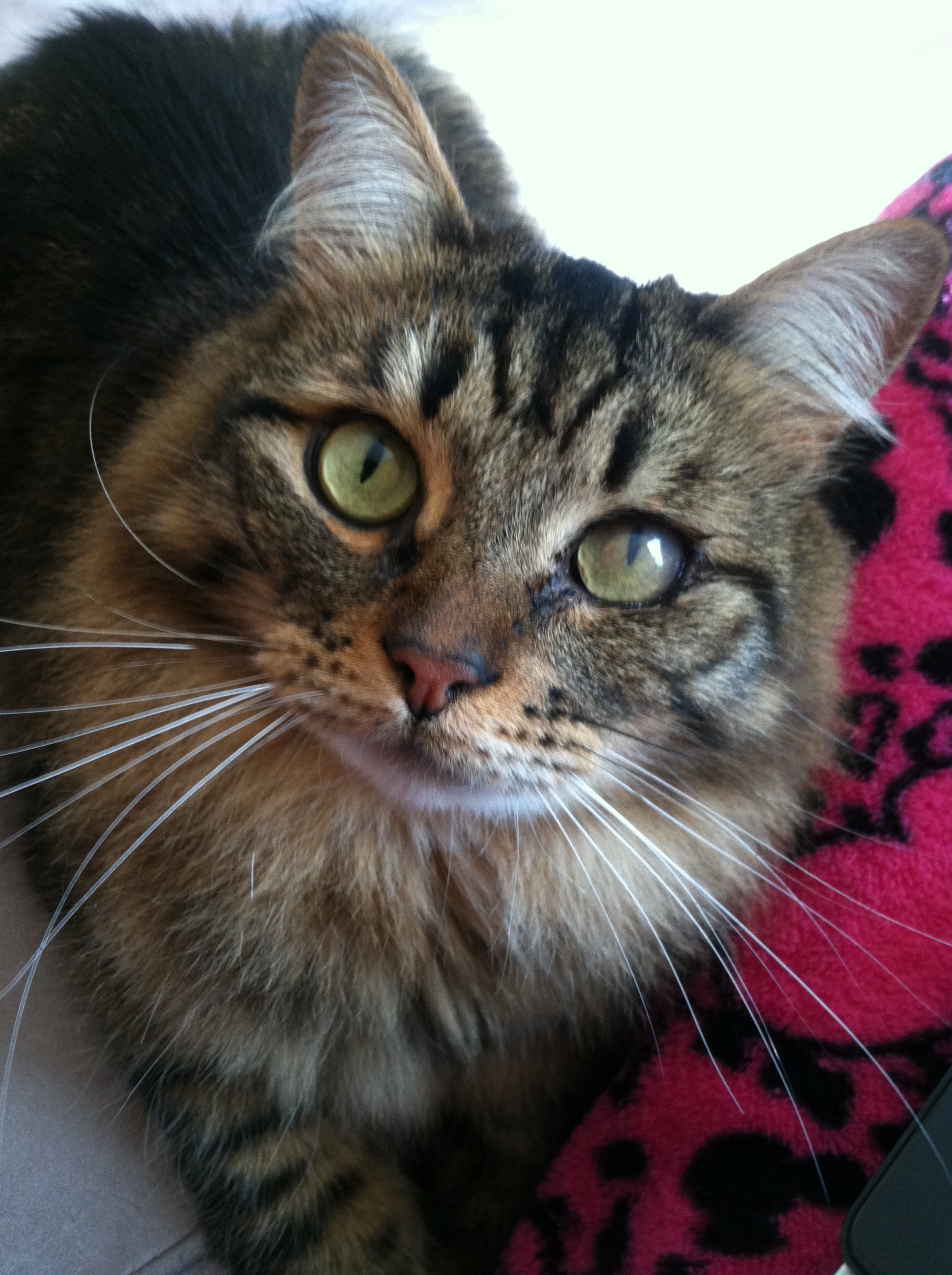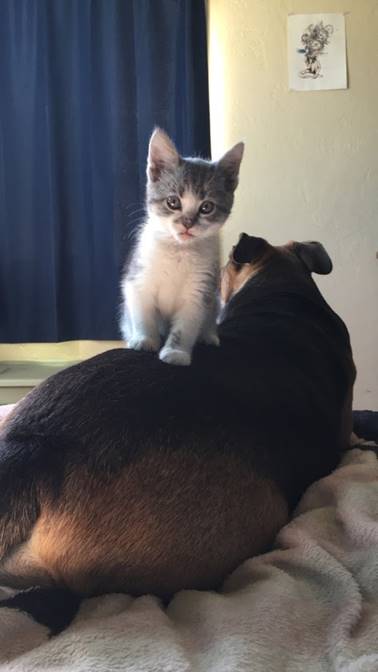Mak Case Overview
 Wednesday, January 14, 2015 at 01:00PM
Wednesday, January 14, 2015 at 01:00PM Annette Louviere - Georgia
Cases/Abstracts - Winner
As a third year veterinary student, my best study aid has always been my own cat, not that this is something to brag about. Since a young age Mak has never had a “simple problem” and his latest riddle is no exception. For the purpose of preserving length in this case overview, I will leave out specifics of medication dosages he is not currently receiving; however, every medication administered to Mak fell within Plumb’s Veterinary Drug Handbook dosage recommendation for felines.
 Mak is a 6-year-old male neutered Siberian cat. From a young age he gradually progressed to daily vomiting episodes; however, prior to vet school my main concern was to contain the catastrophe that was his left eye. From his first introduction as a tiny kitten, Mak has battled ophthalmologic conditions ranging from deep corneal ulcerations to eosinophilic keratitis. It wasn’t until I was a veterinary student that the CVM Ophthalmology Department diagnosed Mak with herpetic stromal keratitis OS. While his left eye is a chronic condition, it is currently contained and doing well enough to not need treatment; this has allowed me to focus on to his other issue – chronic/progressive vomiting.
Mak is a 6-year-old male neutered Siberian cat. From a young age he gradually progressed to daily vomiting episodes; however, prior to vet school my main concern was to contain the catastrophe that was his left eye. From his first introduction as a tiny kitten, Mak has battled ophthalmologic conditions ranging from deep corneal ulcerations to eosinophilic keratitis. It wasn’t until I was a veterinary student that the CVM Ophthalmology Department diagnosed Mak with herpetic stromal keratitis OS. While his left eye is a chronic condition, it is currently contained and doing well enough to not need treatment; this has allowed me to focus on to his other issue – chronic/progressive vomiting.
Using food trials and laboratory workups performed during this past year, Mak was diagnosed through exclusion with inflammatory bowel disease and/or gastritis. Treatment started with a new round of hypoallergenic food trials, each lasting several months, combined with metronidazole and, eventually, Cerenia as needed to control vomiting episodes. When his vomiting returned after discontinuing Cerenia, B12 shots were implemented as an additional trial. Again, no change in the frequency of vomiting episodes. At this point he began showing signs of food aversion as well as significant weight loss and his diet was changed to another hypoallergenic food brand. Metoclopramide was added as an anti-emetic as well as a gut motility enhancer. This seemed to work for 2 weeks; however, on the third week he began vomiting again. During the same week, dark stools were also noted and the possibility of gastric ulcer(s) forming was discussed with his general DVM. His treatment protocol was adjusted as well as his diet (again, due to food aversion). He was placed on Iams Intestinal Plus diet and his medication protocol changed to: metronidazole, Cerenia, Pepcid, and amoxicillin. The antibiotic was started as an empirical treatment for Helicobacter felis infection. After 10 days on this treatment plan, Mak became anorexic. Lab work was performed and radiographs were taken. The abnormalities shown on his full chemistry, CBC, T4, and UA were as follows:
Superchem:
AST 144 (normal: 10-100)
ALT 432 (normal: 10-100)
Urine sample collected via cystocentesis:
USG 1.064 (1.015-1.060)
Protein 2+ (Neg)
Blood 2+ (Neg)
RBC 11-20 (0-3)
 After consulting with radiologists at the veterinary school, the only true abnormality revealed on the images was the rounded margins of his heart. It is my understanding that with Mak being an underweight purebred cat the top (only?) differential is hypertrophic cardiomyopathy. This surprise; however, did not lend any insight as to Mak’s cause of vomiting.
After consulting with radiologists at the veterinary school, the only true abnormality revealed on the images was the rounded margins of his heart. It is my understanding that with Mak being an underweight purebred cat the top (only?) differential is hypertrophic cardiomyopathy. This surprise; however, did not lend any insight as to Mak’s cause of vomiting.
Following the lab work, his treatment plan was adjusted from amoxicillin to Clavamox and an appetite stimulant, mirtazapine, was added. Enrofloxacin was discussed as an additional antibiotic to add in case there was translocation of gut flora to the liver; however, before a decision was made about enrofloxacin, his stools became liquid diarrhea corresponding with administration of the latest medications. This development led to removal of all antibiotics in the medical protocol. Additionally, over time Mak became increasingly hard to pill – when in the past he was the ideal patient, even eating medications hidden inside of treats. This change lead to several stressful occasions for both Mak and I; and, eventually, as most cat owners do, I succumbed to his stubbornness and took him off his medicine regimen of once-twice daily administration of metronidazole, mirtazapine, Pepcid, and Cerenia. Only Cerenia and mirtazapine were given as need.
After much discussion with numerous clinicians and consultation of all the resources a vet student can take advantage of, the top differentials explaining the liver enzyme elevation in Mak’s case were narrowed down to: hepatitis, possibly from bacterial translocation, or mild/early hepatic lipidosis. Following this news, Mak was submitted to the CVM Radiology Department to undergo an abdominal ultrasound. Once again, the diagnostic imaging did not appreciate anything of concern within Mak’s GI tract; however, a probable left pancreatic cyst was observed and sludge was noted in the urinary bladder. The liver and gall bladder were remarkably normal which did not rule out issues but was still acceptable news from an owner’s perspective.
Mak’s diet was once again changed, this time to any feline diet he would/could eat and the addition of the probiotic FortiFlora was made. Repeat blood work was sent to the same lab approximately one month after the liver enzyme elevation was noted – and to everyone’s surprise, and to my delight, his liver enzymes were normal.
Throughout the course of Mak’s treatment, the use of immunosuppressants, such as prednisone/prednisolone, have been discussed in length with Mak’s general DVM as well as other clinicians; unfortunately, there are conflicting views as to whether or not the medication should be administered in Mak’s case and so have been avoided thus far. Additionally, as a “typical” veterinary student, it is out of my financial ability to perform an endoscopic procedure or exploratory surgery to obtain biopsies for a true diagnosis of this GI condition. Currently Mak is being sustained on a diet of non-prescription canned adult cat food mixed with 1 packet of FortiFlora daily, his vomiting has decreased with the exception of getting into the other cat’s dry food, and he has even managed to gain one pound. While I cannot definitively name a disease process afflicting Mak, I can say he is one of the most tolerant felines I have had the pleasure of working with. A non-biased opinion, of course…
 Cases,
Cases,  Cat,
Cat,  Georgia in
Georgia in  Cases/Abstracts
Cases/Abstracts 